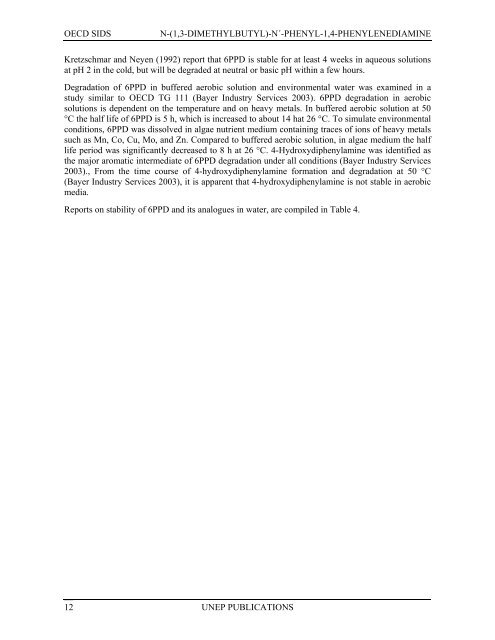N-(1,3-Dimethylbutyl)-N
N-(1,3-Dimethylbutyl)-N
N-(1,3-Dimethylbutyl)-N
You also want an ePaper? Increase the reach of your titles
YUMPU automatically turns print PDFs into web optimized ePapers that Google loves.
OECD SIDS<br />
N-(1,3-DIMETHYLBUTYL)-N´-PHENYL-1,4-PHENYLENEDIAMINE<br />
Kretzschmar and Neyen (1992) report that 6PPD is stable for at least 4 weeks in aqueous solutions<br />
at pH 2 in the cold, but will be degraded at neutral or basic pH within a few hours.<br />
Degradation of 6PPD in buffered aerobic solution and environmental water was examined in a<br />
study similar to OECD TG 111 (Bayer Industry Services 2003). 6PPD degradation in aerobic<br />
solutions is dependent on the temperature and on heavy metals. In buffered aerobic solution at 50<br />
°C the half life of 6PPD is 5 h, which is increased to about 14 hat 26 °C. To simulate environmental<br />
conditions, 6PPD was dissolved in algae nutrient medium containing traces of ions of heavy metals<br />
such as Mn, Co, Cu, Mo, and Zn. Compared to buffered aerobic solution, in algae medium the half<br />
life period was significantly decreased to 8 h at 26 °C. 4-Hydroxydiphenylamine was identified as<br />
the major aromatic intermediate of 6PPD degradation under all conditions (Bayer Industry Services<br />
2003)., From the time course of 4-hydroxydiphenylamine formation and degradation at 50 °C<br />
(Bayer Industry Services 2003), it is apparent that 4-hydroxydiphenylamine is not stable in aerobic<br />
media.<br />
Reports on stability of 6PPD and its analogues in water, are compiled in Table 4.<br />
12<br />
UNEP PUBLICATIONS
















